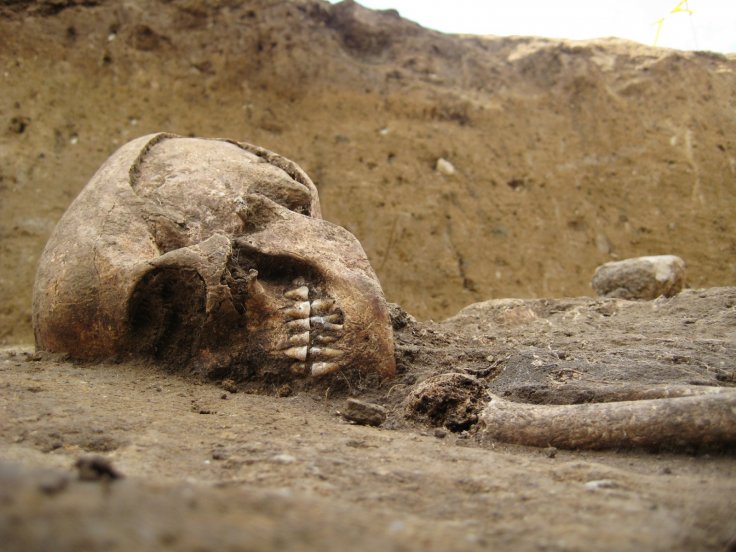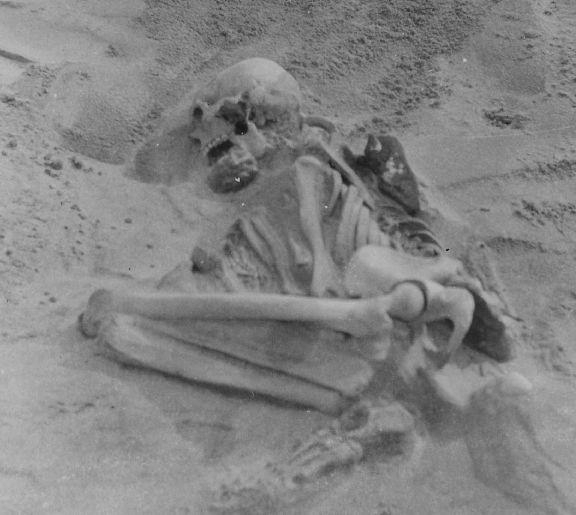During an excavation in Uckermark in Brandenburg, Germany archaeologists discovered a skeleton of an ancient woman which is thought to be around 4,000 to 4,500-year-old. But the surprising fact is that the excavators found these remains in a crouching position.
The archaeologists noticed that the ancient woman had been laid on her right side with her with legs and arms pulled in towards the chest and her face is towards the north. It should be noted that this particular position is one of the oldest form and a common burial position in Neolithic Europe, which lasted from 6,000 to 2,000 BCE. In 2015, a Rickets stricken Neolithic skeleton from the Scottish island of Tiree, showed similar features.
As per Deutsche Welle reports, Christof Krauskopf from Brandenburg's state office for monument preservation said that the woman is believed to have been buried between 2,200 and 2,500 B.C. But the exact date of her burial is unclear. However, the archaeologists believe that further study is needed to determine both the age of the skeleton and how old the woman was when she died.
As per Krauskopf, this discovery of the ancient skeleton could help "answer questions about the spread of cultures in the development of mankind," reported Rundfunk Berlin-Brandenburg (RBB) 24.

The unknown skeleton in Brandenburg
The archaeologists could not find any grave items that might have offered clues to solve the mystery of the burial. Philipp Roskoschinski, one of the archaeologists involved in the dig, told a German newspaper Tagesspeigel, "Unfortunately there were no other finds in the grave that could tell us more about the life of the woman," and added that "the place was lovingly bordered with field stones."
Roskoschinski and Christoph Rzegotta, a fellow archaeologist at Archaeros, came across the ancient skeleton of the woman during excavation work for a wind turbine. After the finding Roskoschinski said, "I've never found anything like this,".
Along with Roskoschinski, other archaeologists involved in this excavation program have said that the body was buried in a pit near a settlement, not in a cemetery. It should be mentioned that the archaeologists will take their investigation to the laboratory tests to understand the correct the age of the skeleton.
Brandenburg lebt auf: Berliner Archäologen haben das Skelett einer Frau ausgegraben, die womöglich vor 4000 Jahren hier gelebt hat. Nun soll der seltene Fund untersucht werden - auch um zu klären, ob sie eine Zugezogene war. Mehr dazu am Mittwoch im #Checkpoint vom @Tagesspiegel pic.twitter.com/MqzgRkszIR
— Robert Ide (@ichgruessesie) May 20, 2020
As per the reports, an anthropologist will also check the ancient bones for signs of any disease as well as clues for the woman's eating habits and cause of death. In this case, genetic testing could be used to determine the unidentified woman's connection to what is now known as Uckermark, a district an hour's drive north of Berlin.
As per the archaeologists the results may help the researchers to find out if she had ancestors in the area, or if she was a traveler from another region.
Rickets stricken?
In 2015, a Rickets stricken Neolithic skeleton from the Scottish island of Tiree, showed similar features according to a study published in Proceedings of the Prehistoric Society, was partly funded by Historic Scotland with similar deformity.
The rickets disease - caused by Vitamin D deficiency linked to lack of sunlight - is more commonly associated with the urban slums of Victorian Britain in Neolithic Scotland. The woman, physically deformed by the disease, was discovered along with three other burials during an excavation in 1912.

The skeleton was dated between 3340 and 3090 BC, placing it firmly in the Neolithic period. The bones show a number of deformities that are caused by rickets - particularly in the breastbone, ribs, and the arms and legs. These would have left the woman pigeon-chested with misshapen limbs - all characteristic of the disease.
Dr Janet Montgomery from Durham University said: "Malnutrition or illness as a child, lack of sunlight growing up, deformity and disability as an adult and finally a burial without the usual rites afforded during Neolithic times, seem to be the sad life history of this woman, based on our study of original documents from the excavation and analysis of the skeleton itself."









